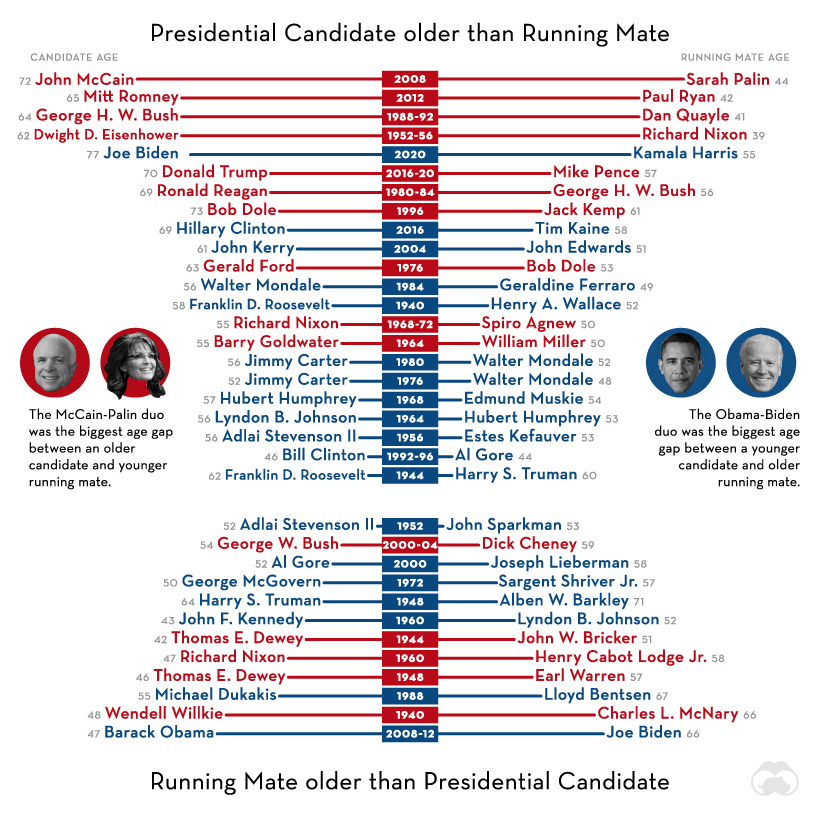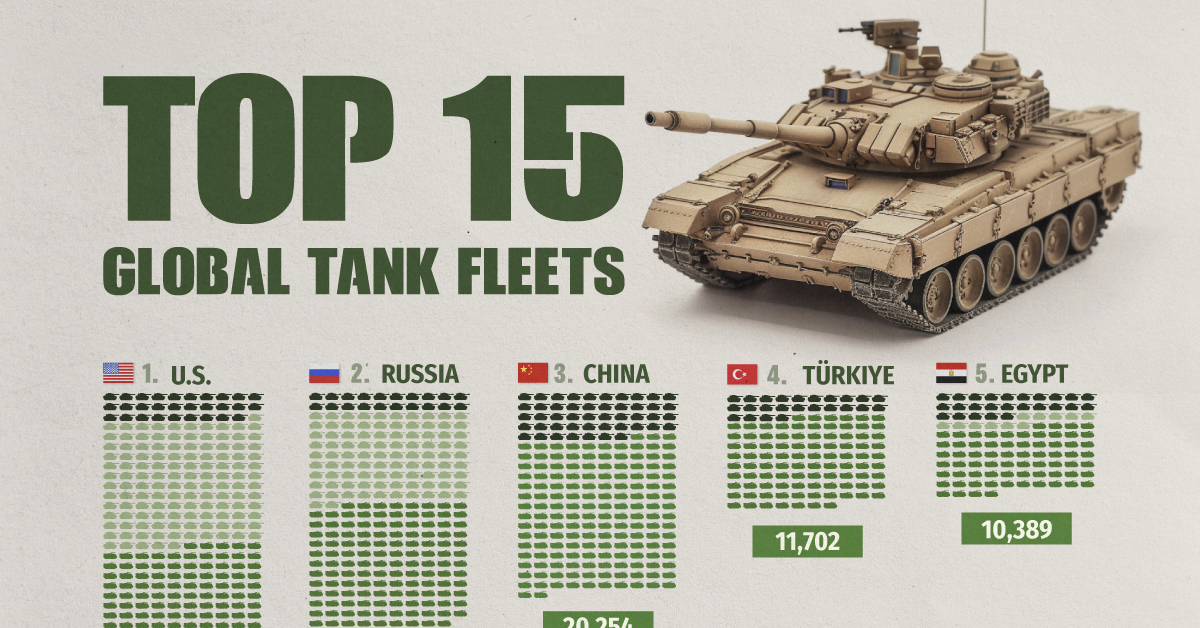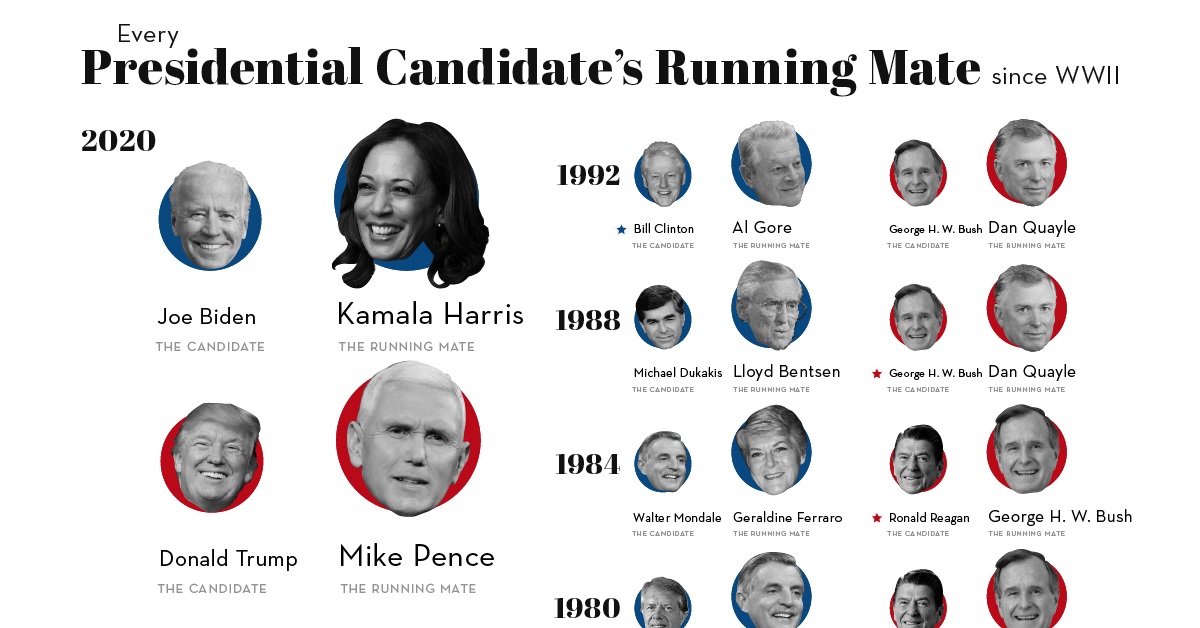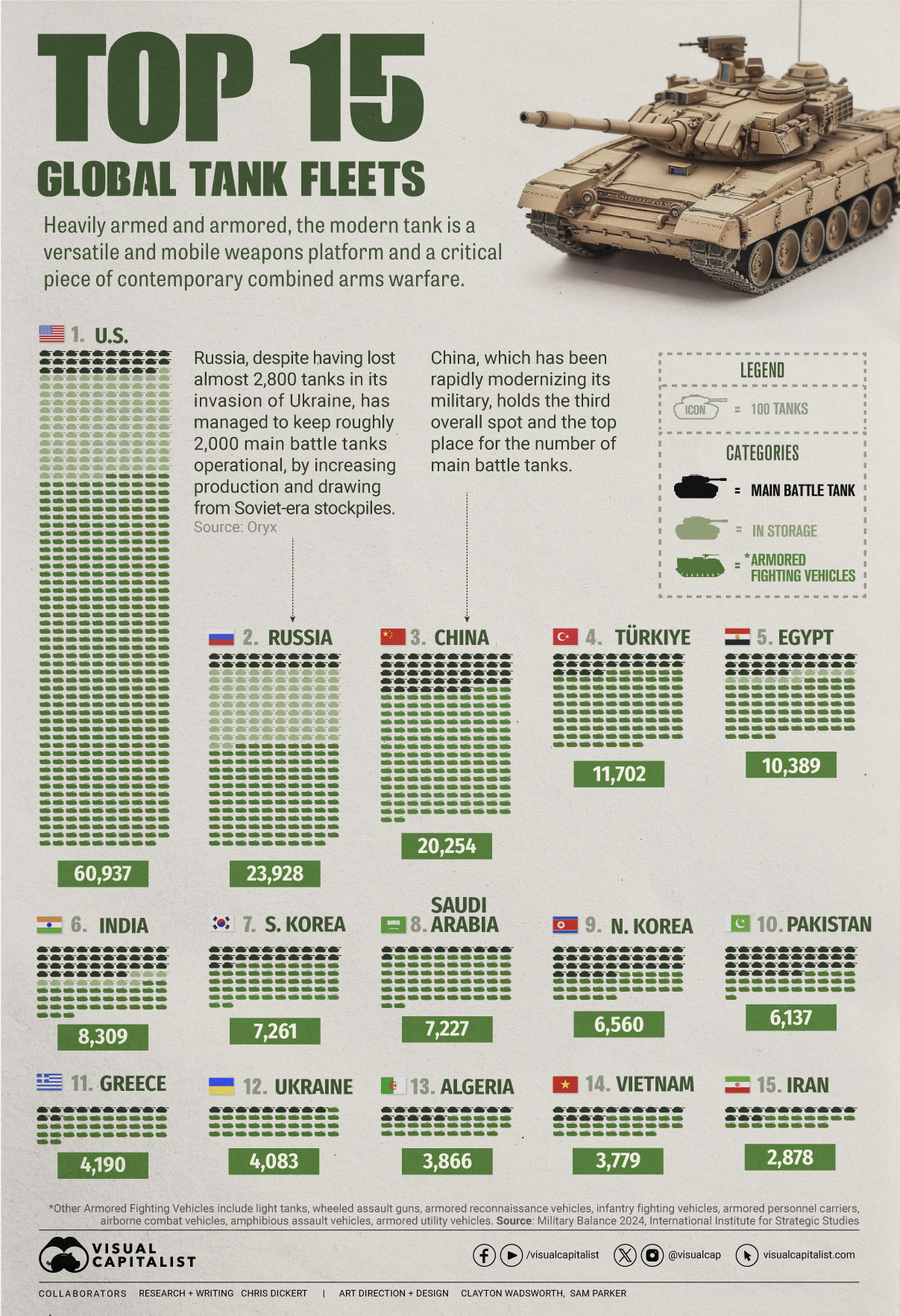Politics
Every Presidential Candidate’s Running Mate Since WWII

Every Presidential Candidate’s Running Mate Since WWII
Since the U.S. Constitution was first instituted, there have been 48 vice presidents. They’ve supported presidents in seeing the country through wars, economic expansions and contractions, a global pandemic—and much more.
A president’s success depends on the strength of their team, so it’s only natural that as second-in-command, the pick for a VP carries significant weight. In some cases, they can even make or break the race to secure a spot in the White House.
In this graphic, we take a look at the hand-picked running mates of presidential hopefuls since 1940, including the upcoming November 2020 elections.
Running More Than Once
The graphic highlights 33 running mates, out of which nine have ran for VP more than once. Here’s how their number of terms compare, and who continued on to become an eventual presidential candidate:
| Running Mate | Party | VP terms served | Presidential candidate? |
|---|---|---|---|
| Mike Pence | 🔴 R | Won 1 term Currently running for second term | No |
| Joe Biden | 🔵 D | Won both terms | Currently running for president |
| Dick Cheney | 🔴 R | Won both terms | No |
| Al Gore | 🔵 D | Won both terms | Yes, but did not win first term |
| Dan Quayle | 🔴 R | Won 1 out of 2 terms | No |
| George H. W. Bush | 🔴 R | Won both terms | Yes, won one term |
| Spiro Agnew | 🔴 R | Won both terms | Resigned during VP second term |
| Richard Nixon | 🔴 R | Won both terms | Yes, won both terms |
| Walter Mondale | 🔵 D | Won 1 out of 2 terms | Yes, but did not win first term |
Of the running mates since WWII, Republicans Richard Nixon and George H. W. Bush are the only two to have served as president after being vice presidents for two previous terms—unless Joe Biden wins in November 2020.
Prior Gigs
What career paths did aspiring VPs take before running on the big ticket?
Interestingly, 2 of 3 running mates profiled in today’s graphic had a prior background as a lawyer before choosing to enter politics.
A curious exception to the typical career path is that of former professional football player Jack Kemp, who was chosen as the running mate for Bob Dole’s unsuccessful presidential bid in 1996.
At the President’s Right Hand
The vice president is the first in line of succession for the Oval Office, in the event that the sitting president dies, resigns, or is removed from office. Throughout history, nine VPs have ascended to presidency this way, of which three occurred since 1940.
- After Franklin D. Roosevelt’s death in 1945, Harry S. Truman ascended to the presidency.
- Lyndon B. Johnson became the President upon John F. Kennedy’s assassination in 1963.
- Following evidence of political corruption, Spiro Agnew resigned in 1973. He was replaced by Gerald Ford, who then became President after Nixon’s post-Watergate resignation in 1974.
Richard Nixon, Bill Clinton, and Donald Trump are three Presidents who have been through the impeachment process, but were later acquitted by the Senate. Otherwise, the list of VPs ending up as the commander-in-chief might look much more different.
The Youngest and Oldest Running Mates
Based on the first time they ran on the ticket, the average running mate is 54 years old. In contrast, the average presidential candidate is 58 years old.
Comparing the age difference between presidential candidates and their running mates paints a unique picture. The biggest age gaps both occurred in 2008:

There was a 28-year difference between older candidate John McCain (72) and younger VP pick Sarah Palin (44) on the Republican ticket. On the Democratic side, younger candidate Barack Obama (47) and older VP pick Joe Biden (66) saw a 19-year gap.
Harry S. Truman’s historic win in 1948 was considered a surprising political longshot. His running mate, Alben W. Barkley was the oldest running mate ever picked, 71 years at the time.
Meanwhile, Richard Nixon was one of the youngest running mates to be chosen, 39 years in 1956—second only to John C. Breckinridge (36 years old in 1856). Finally, at age 92 years in 2020, Walter Mondale is the oldest living former VP.
Cracking the Glass Ceiling
Last but not least, there have only been three women selected as VP running mates to date.
- Geraldine Ferraro became the first woman VP nominee for the Democratic Party in 1984.
- Although she had only two years of political experience as governor of Alaska, Sarah Palin was the first female Republican VP nominee in 2008.
- Kamala Harris, a former prosecutor with almost four years of experience as a Senator, is the first woman of color to be nominated on any major party’s ticket in 2020.
Palin herself shared a few words of wisdom for Harris across the aisle:
Congrats to the democrat VP pick 🇺🇸 Climb upon Geraldine Ferraro’s and my shoulders, and from the most amazing view in your life consider lessons we learned…
—Sarah Palin (via Instagram)
Could Harris become the first ever right-hand woman? We’ll find out in a few months.
War
Visualized: Top 15 Global Tank Fleets
Heavily armed and armored, the modern tank is a versatile and mobile weapons platform, and a critical piece of contemporary warfare.

The Top 15 Global Tank Fleets
This was originally posted on our Voronoi app. Download the app for free on iOS or Android and discover incredible data-driven charts from a variety of trusted sources.
Heavily armed and armored, the modern tank is a versatile and mobile weapons platform, and a critical piece of contemporary warfare.
This visualization shows the top 15 global tank fleets, using data from the 2024 Military Balance report from the International Institute for Strategic Studies (IISS).
Let’s take an in-depth look at the top three fleets:
1. United States
As the world’s pre-eminent military power, it’s perhaps no surprise that the United States also has the largest tank fleet, by a wide margin.
In total, they have just over 45,000 armored fighting vehicles in operation, along with 2,640 main battle tanks (MBTs), and 12,800 vehicles in storage, of which 2,000 are main battle tanks.
| Category | Vehicles | Global rank |
|---|---|---|
| Main battle tanks | 2,640 | 4 |
| Armored reconnaissance | 1,745 | 1 |
| Infantry fighting vehicles | 3,262 | 3 |
| Armored personnel carriers | 10,644 | 1 |
| Amphibious assault vehicles | 1,401 | 1 |
| Armored utility vehicles | 28,445 | 1 |
| Storage | 12,800 | 1 |
| Total | 60,937 | 1 |
The U.S. is internalizing the lessons from the ongoing invasion of Ukraine, where Western-supplied anti-tank weapons and massed Ukrainian artillery have been cutting Russian tanks to pieces. As a result, the U.S. recently canceled an upgrade of the M1 Abrams in favor of a more ambitious upgrade.
Meanwhile, the U.S. is nervously eyeing a more confident China and a potential clash over Taiwan, where air and naval forces will be critical. However, a recent war game showed that Taiwanese mechanized ground forces, kitted out with American-made tanks and armored fighting vehicles, were critical in keeping the island autonomous.
2. Russia
According to Oryx, a Dutch open-source intelligence defense website, at time of writing, Russia has lost almost 2,800 main battle tanks since invading Ukraine. Considering that in the 2022 edition of the Military Balance, Russia was estimated to have 2,927 MBTs in operation, those are some hefty losses.
Russia has been able to maintain about 2,000 MBTs in the field, in part, by increasing domestic production. Many defense plants have been taken over by state-owned Rostec and now operate around the clock. Russia is also now spending a full third of their budget on defense, equivalent to about 7.5% of GDP.
At the same time, they’ve also been drawing down their Soviet-era stockpiles, which are modernized before being sent to the front. Just how long they can keep this up is an open question; their stockpiles are large, but not limitless. Here is what their storage levels look like:
| Category | 2023 | 2024 | YOY change |
|---|---|---|---|
| Main battle tanks | 5,000 | 4,000 | -20.0% |
| Armored reconnaissance | 1,000 | 100 | -90.0% |
| Infantry fighting vehicles | 4,000 | 2,800 | -30.0% |
| Armored personnel carriers | 6,000 | 2,300 | -61.7% |
| Total | 16,000 | 9,200 | -42.5% |
3. China
China holds the third overall spot and top place globally for the number of main battle tanks in operation. Untypically, the People’s Liberation Army has no armored vehicles in storage, which perhaps isn’t surprising when you consider that China has been rapidly modernizing its military and that stockpiles usually contain older models.
China also has one of the world’s largest fleets of armored fighting vehicles, second only to the United States. Breaking down that headline number, we can also see that they have the largest number of light tanks, wheeled guns, and infantry fighting vehicles.
| Category | Vehicles | Global rank |
|---|---|---|
| Main battle tanks | 4,700 | 1 |
| Light tanks | 1,330 | 1 |
| Wheeled guns | 1,250 | 1 |
| Infantry fighting vehicles | 8,200 | 1 |
| Armored personnel carriers | 3,604 | 5 |
| Airborne combat vehicles | 180 | 2 |
| Amphibious assault vehicles | 990 | 2 |
| Total | 20,254 | 3 |
This is equipment that would be integral if China were to make an attempt to reunify Taiwan with the mainland by force, where lightly armored mechanized units need to move with speed to occupy the island before Western allies can enter the fray. It’s worth noting that China also has one of the world’s largest fleets of amphibious assault vehicles.
End of the Tank?
Many commentators at the outset of Russia’s invasion of Ukraine, were quick to predict the end of the tank, however, to paraphrase Mark Twain, reports of the tank’s demise are greatly exaggerated.
With the U.S. and China both developing remote and autonomous armored vehicles, tanks could be quite different in the future, but there is nothing else that matches them for firepower, mobility, and survivability on the modern battlefield today.
-

 Green2 weeks ago
Green2 weeks agoRanked: Top Countries by Total Forest Loss Since 2001
-

 Travel1 week ago
Travel1 week agoRanked: The World’s Top Flight Routes, by Revenue
-

 Technology1 week ago
Technology1 week agoRanked: Semiconductor Companies by Industry Revenue Share
-

 Money2 weeks ago
Money2 weeks agoWhich States Have the Highest Minimum Wage in America?
-

 Real Estate2 weeks ago
Real Estate2 weeks agoRanked: The Most Valuable Housing Markets in America
-

 Markets2 weeks ago
Markets2 weeks agoCharted: Big Four Market Share by S&P 500 Audits
-

 AI2 weeks ago
AI2 weeks agoThe Stock Performance of U.S. Chipmakers So Far in 2024
-

 Automotive2 weeks ago
Automotive2 weeks agoAlmost Every EV Stock is Down After Q1 2024


















